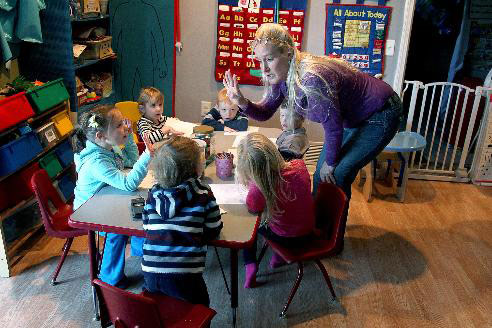
|
Deborah Stenseng had an unusual way of comforting infants in her home day care. When they got fussy or wouldn't take a bottle, the Duluth woman opened her shirt and had them suckle on her breast, even though she wasn't lactating or breast-feeding children of her own. Worse, Stenseng deceived some parents about the practice and defied others who asked her not to do it with their children, regulators later concluded. Eventually, a complaint reached St. Louis County authorities, who shut down Stenseng's day care in January and revoked her license in April. "Serious personal boundaries ... were crossed," licensing officials concluded. Though extreme, Stenseng's case reflects an inherent problem in licensed family child care -- a problem that may be linked to a recent increase in child care deaths in Minnesota. Operating with minimal training, spotty inspections and inconsistent rule enforcement from one county to another, home-based providers can engage in practices that range from inappropriate to dangerous as they care single-handedly for as many as a dozen children. Minnesota has some of the leanest training requirements in the nation for in-home child care, according to a Star Tribune review of licensing data. Providers don't need high school diplomas or child development expertise to get licensed. Inspections are required only every two years, and one watchdog group estimates that Minnesota's ratio of inspectors to providers is among the nation's lowest. The risk is that low standards result in low quality, said Amie Lapp Payne, who wrote an influential 2011 report for the National Association for Regulatory Administration on child-care safety. "If it isn't a regulatory requirement, they aren't going to do it," she said. Even with lax standards, thousands of Minnesota day-care providers nurture children skillfully, with no deaths or safety violations. But a review of public records shows that the rules allow substandard operators to stay in business and place children at risk. One former provider in Delano, for example, shoved a child's face into a pool of urine on her floor in early 2010 after discovering that the child had had a toileting accident. Documents show that the woman pressed hard enough to bruise the child's forehead. Other providers dunked children in water, put hot sauce on their tongues, or grabbed or hit them hard enough to break bones. Altogether, the newspaper found 70 cases of corporal punishment since 2007 -- even though it is forbidden under state law. In the last decade, the Legislature has considered raising training and safety standards for home child care several times. But lawmakers have repeatedly hedged, out of concern that higher standards would increase costs or represent government intrusion for these small businesses. Even the Minnesota Licensed Family Child Care Association, which represents small, in-home providers, has encountered resistance when seeking more funding so that providers could be mentored by experienced colleagues. "[It's] the idea that, 'Why do people who are taking care of little kids need this?' " said Katy Chase, the association's executive director. "There's just a feeling we're born able to properly care for children." The result is a two-tier child-care system: Roughly 1,500 large child-care centers with more employees, higher training requirements and inspections by Minnesota regulators; and about 11,100 small in-home day cares, where providers often operate in isolation with little support and scrutiny. 'Adults get worn down' Reviewing licensing documents and death records, the Star Tribune found that 82 of 85 deaths in licensed child care since 2002 have taken place in homes, not centers. The number of deaths has nearly doubled in the past five years. One of the few researchers to examine the causes of child-care deaths nationally said the absence of oversight increases risks for children. Julia Wrigley, a sociologist at the City University of New York, found a higher rate of deaths in the nation's licensed home day cares than in centers. She concluded that large child-care centers are safer because they have multiple workers on hand to monitor children and stop co-workers from making mistakes. "Adults can get worn down. They can get distraught and frustrated and these all can be risk factors when caring for a lot of little kids," she said. "If you have other adults there ... they can ensure that safe standards are maintained." A Star Tribune review of 1,100 disciplinary actions issued since 2007 against Minnesota licensed day-care homes showed that the isolation of providers can play a significant role. More than 300 sanctions resulted from lapses in child supervision -- often because providers were spread thin. In Rochester in 2010, a provider confined two preschoolers to a basement for seven hours (keeping one in a 4-foot-square pen) to keep them away from a furnace repair man. At a Rose Creek day care last fall, a 1-year-old was left unattended and wandered two blocks away to a hardware store. Tighter enforcement? To aid providers who are struggling with safety and quality, advocates believe Minnesota needs tougher standards and enforcement. Many child deaths reviewed by the Star Tribune involved providers who didn't follow even basic safe-sleeping rules. At least 10 deaths since 2007 involved infants placed to sleep on their stomachs -- a clear violation of guidelines -- or on unsafe surfaces. Several deaths involved napping infants who weren't checked for long periods of time -- in one case three hours. The state requires that in-home providers and center workers be within sight or hearing of sleeping infants. But only at child-care centers are workers required, in most cases, to visually check sleeping infants every 15 minutes. In Kansas, which overhauled its child-care rules in 2010, in-home caregivers must check on sleeping children every 15 minutes. It is one of at least six states that require in-home providers to observe children during their nap times. In a May 3 letter to family providers, Minnesota Department of Human Services Inspector General Jerry Kerber said his agency would examine the "vast differences" in death figures between centers and licensed homes, and whether additional training or supervision is needed. In addition, some advocates believe Minnesota needs better day-care inspections. Child Care Aware of America, a research and watchdog group, estimates that Minnesota has one county inspector for every 150 family child care homes -- 10th worst in the nation. Actual rates vary widely by county. In Anoka County, three inspectors have caseloads of more than 200 providers and aren't able to spend as much time with individual providers as they would like. "If we're really wanting to know what's going on in a home, the best way ... is to be there in person, eyeball to eyeball," said Evelyn Nelson, who supervises the Anoka office. "We don't have the people power to do that." In 26 states, inspections occur at least once a year, with 14 states inspecting in-home providers twice a year or more, according to Child Care Aware of America's survey. Four states inspect at least quarterly, including Wyoming, where there is an inspector for every 66 home child care providers. Better training? Better training of child care providers also can improve the quality of care, according to several research studies. Minnesota requires in-home providers to be trained in first aid and CPR before they are licensed, but no training in child development is required until after they open. The state's requirement of eight hours of annual training was 33rd lowest among 42 states that license small child care homes, according to Child Care Aware. Wisconsin requires at least 40 hours of initial training, including child development, and then 18 hours annually. "We think [training] increases the likelihood children will be safer in care," said Grace Reef, Child Care Aware's public policy director. "But it's also about healthy [child] development." Responding to the Star Tribune's ongoing investigation, state regulators recently recommended increased training in safe sleep positioning and CPR. Yet proposals to increase training can face political resistance. In 2006 Minnesota increased its annual training requirement from six hours to eight after lawmakers opposed increasing the total to 12. "Conservatives railed against 'the nanny state,' " said John Hottinger, a former DFL state senator who sponsored the training bill. Some legislators remain skeptical of more regulation. "It never ends. We add regulation on regulation, training on training," said Rep. Steve Gottwalt, R-St. Cloud. "Unless you've got real good evidence that six hours results in 'X' amount of better safety for kids, then why not 12 hours? Why not 36 hours? Why not require day-care providers to have a master's degree?" Training isn't a cure-all, Wrigley said. Her deaths study concluded that the environment of family child care was more problematic than a lack of education. And Stenseng, the provider who lost her license because she used breast-suckling to control behavior, had college training in psychology and social work. Stenseng said she created her own licensed child care because she was dissatisfied with options for her children and wanted to create a facility that supported alternatives such as cloth diapers, attachment parenting and extended breast-feeding. She disagreed with the state report, arguing that most parents were aware of her "comfort nursing" practice. "To them," she said, "it was a very natural fit" with their parenting philosophies. Katy Chase of the Family Child Care Association believes providing more mentors would raise child-care quality. Public funding covers mentoring for only five providers a year, she noted. Payne, the author of national child-care guidelines, said ultimately it's up to states to ensure safety at home-based day care. "This is their house," she noted. "But is it safe enough for kids? That's the bottom-line question." |
在一個(gè)位于明尼蘇達(dá)州德盧斯的家庭托兒所中,德博拉·斯坦森用一種不尋常的方式來(lái)安慰嬰兒。每當(dāng)嬰兒吵鬧或不喝奶時(shí),她會(huì)解開(kāi)衣服,讓嬰兒吮吸自己的乳房,但她并沒(méi)有分泌乳汁或在給自己的孩子喂奶。 監(jiān)督機(jī)構(gòu)后來(lái)發(fā)現(xiàn),更糟的是,一些父母對(duì)斯坦森這種做法毫不知情,另一些父母要求她不要這樣帶他們的孩子,她卻公然違背了這些父母的要求。最后,有人向圣路易斯縣有關(guān)監(jiān)督部門(mén)投訴,監(jiān)督部門(mén)1月取締了斯坦森的托兒所,4月吊銷了她的執(zhí)照。頒發(fā)執(zhí)照的官員說(shuō):“她越過(guò)了身體接觸的界限,事態(tài)很嚴(yán)重。” 斯坦森的例子雖然很極端,但也反映出獲得營(yíng)業(yè)執(zhí)照的家庭托兒所中存在的固有問(wèn)題——這個(gè)問(wèn)題也許與近日明尼蘇達(dá)州托兒所死亡事件增加有關(guān)聯(lián)。缺乏培訓(xùn)、定期檢查過(guò)少及各個(gè)縣法律執(zhí)行力度不一,在這種情況下?tīng)I(yíng)業(yè)的家庭托兒所負(fù)責(zé)人獨(dú)自照料多達(dá)12個(gè)兒童時(shí),可能會(huì)采取各種方法,包括不恰當(dāng)或危險(xiǎn)的方法。 《星論壇報(bào)》檢查執(zhí)照的數(shù)據(jù)后發(fā)現(xiàn),明尼蘇達(dá)州對(duì)家庭托兒所的培訓(xùn)要求是全美最寬松的。家庭托兒所負(fù)責(zé)人無(wú)需有高中文憑或兒童發(fā)育的專門(mén)知識(shí)就可以獲得執(zhí)照;每?jī)赡瓴胚M(jìn)行一次檢查。一個(gè)監(jiān)察組織估計(jì)在明尼蘇達(dá)州,檢查員與托兒所負(fù)責(zé)人的比率是全美最低的。 “風(fēng)險(xiǎn)就在于低標(biāo)準(zhǔn)造成低質(zhì)量,”阿米·拉普·佩恩說(shuō),“如果不是法規(guī)要求,那些負(fù)責(zé)人不會(huì)去做。”阿米曾在2011年為“全美兒童保育安全監(jiān)督管理協(xié)會(huì)”寫(xiě)過(guò)一篇影響頗深的報(bào)告。 在明尼蘇達(dá)州,即使標(biāo)準(zhǔn)很松,成千上萬(wàn)的托兒所熟練地照顧孩子,沒(méi)有兒童死亡或安全違規(guī)行為。但是查看備案材料后發(fā)現(xiàn),寬松的法規(guī)縱容不合格的托兒所經(jīng)營(yíng)者留在托兒所行業(yè),將兒童置于危險(xiǎn)中。比方說(shuō),2010年,德拉諾曾有個(gè)家庭托兒所負(fù)責(zé)人發(fā)現(xiàn)孩子在地上小便后,把那個(gè)孩子的臉按到那灘尿液中。材料顯示那個(gè)女人用力太大,擦傷了孩子的前額。 還有些負(fù)責(zé)人把孩子泡在水里,給孩子喂辣椒醬,或者抓他們、打他們時(shí)用力過(guò)大,造成孩子骨折。《星論壇報(bào)》發(fā)現(xiàn)盡管明尼蘇達(dá)州法律禁止兒童體罰,從2007年起,共發(fā)生了70起這樣的事件。 明尼蘇達(dá)州獲得執(zhí)照家庭托兒所協(xié)會(huì)曾試圖籌得資金,讓家庭托兒所負(fù)責(zé)人接受有經(jīng)驗(yàn)的同行的培訓(xùn),甚至是此舉都受到了阻力。這個(gè)協(xié)會(huì)代表著小型家庭托兒所。 “大家的想法是‘照顧小孩子的人為什么需要培訓(xùn)?’”此協(xié)會(huì)的執(zhí)行理事凱蒂·蔡斯說(shuō),“大家都覺(jué)得我們生來(lái)就會(huì)正確地照顧兒童。” 結(jié)果就是雙重托兒所系統(tǒng):一重是約1500家大型托兒所中心,雇員更多,培訓(xùn)要求更高,由明尼蘇達(dá)州的監(jiān)管部門(mén)定期檢查;另一重是約1.11萬(wàn)家小型家庭托兒所,負(fù)責(zé)人往往獨(dú)立經(jīng)營(yíng),沒(méi)有人幫忙,很少有人來(lái)檢查。 照看者筋疲力盡 通過(guò)查看執(zhí)照文檔和死亡記錄,《星論壇報(bào)》發(fā)現(xiàn),自2002年起,有85次兒童死亡事故,其中82起發(fā)生在家庭托兒所中,而不是托兒中心中。過(guò)去5年中,死亡數(shù)字將近增加了一倍。 有幾位研究者檢查了全美托兒所兒童死亡原因,其中一人表示缺乏監(jiān)督增加了兒童死亡的風(fēng)險(xiǎn)。 紐約城市大學(xué)的社會(huì)學(xué)家茱莉亞·里格麗發(fā)現(xiàn)獲得執(zhí)照的家庭托兒所中兒童的死亡率比托兒中心要高。她的結(jié)論是大型托兒中心更安全,因?yàn)橥袃褐行碾S時(shí)有多位雇員照看小孩,并阻止同事犯錯(cuò)。 “成年人會(huì)筋疲力盡。他們會(huì)變得心煩、受挫。照顧小孩時(shí),這些都可能是風(fēng)險(xiǎn)因素,”茱莉亞說(shuō),“但是如果有其他成人在那,他們可以保證安全。” 過(guò)去十年中,明尼蘇達(dá)州的立法機(jī)關(guān)多次考慮增加家庭托兒所的培訓(xùn)和提高對(duì)他們的標(biāo)準(zhǔn),但由于擔(dān)心提高標(biāo)準(zhǔn)將增加成本,讓人覺(jué)得政府在干預(yù)小型企業(yè),立法者對(duì)此多次閃爍其詞。 《星論壇報(bào)》查看了2007年以來(lái)針對(duì)明尼蘇達(dá)州有執(zhí)照的家庭托兒所發(fā)布的1100項(xiàng)懲戒性措施,結(jié)果發(fā)現(xiàn)隔離家庭托兒所負(fù)責(zé)人作用顯著。超過(guò)300項(xiàng)處罰措施是因?yàn)樨?fù)責(zé)人沒(méi)有照看好孩子,這往往是因?yàn)樗齻儫o(wú)力同時(shí)照顧太多孩子。 2010年,羅切斯特有一名家庭托兒所負(fù)責(zé)人把兩個(gè)學(xué)齡前兒童關(guān)在地下室7小時(shí)(有一個(gè)孩子被關(guān)在約1.2米的籠子里),以讓他們遠(yuǎn)離修爐工。去年秋季,在羅斯克里克的一家日托所里,一個(gè)1歲的孩子無(wú)人照看,獨(dú)自游蕩了兩個(gè)街區(qū),到了一家五金店里。 增強(qiáng)執(zhí)行力度? 為幫助那些盡力保證托兒所質(zhì)量和安全的負(fù)責(zé)人,倡導(dǎo)者認(rèn)為明尼蘇達(dá)州需要設(shè)定更高的標(biāo)準(zhǔn)和增強(qiáng)執(zhí)行力度。 《星論壇報(bào)》查看的眾多幼兒死亡事件中,很多都是由于負(fù)責(zé)人無(wú)法執(zhí)行基本的安全睡眠法則。2007年以來(lái),至少有10起幼兒死亡事件涉及到嬰兒背朝天睡覺(jué)——明顯違反了標(biāo)準(zhǔn)——或在不安全的表面睡覺(jué)。數(shù)起死亡事件涉及到嬰兒睡覺(jué)時(shí),長(zhǎng)時(shí)間無(wú)人查看——有一例中,三個(gè)小時(shí)內(nèi),無(wú)人查看嬰兒。 明尼蘇達(dá)州要求嬰兒睡覺(jué)時(shí),家庭托兒所負(fù)責(zé)人和托兒所中心員工必須能看到或聽(tīng)到孩子的動(dòng)靜。但是往往只有托兒所中心要求員工每15分鐘檢查一下熟睡中的嬰兒。 2010年,堪薩斯州全面修訂了照看兒童的規(guī)定,要求家庭托兒所負(fù)責(zé)人每15分鐘查看一次熟睡中的幼兒。至少有六個(gè)州要求家庭托兒所在孩子小睡期間查看幼兒,堪薩斯州就是其中的一個(gè)。 5月3日,明尼蘇達(dá)州人類服務(wù)部監(jiān)察長(zhǎng)杰里·科伯給家庭托兒所負(fù)責(zé)人寄了一封信,信中說(shuō)道,人類服務(wù)部將查看托兒所中心和獲得許可的家庭托兒所之間幼兒死亡率差別如此之大的原因,看看是否需要給家庭托兒所負(fù)責(zé)人提供額外的培訓(xùn)或監(jiān)督。 另外,一些倡導(dǎo)者認(rèn)為明尼蘇達(dá)州需要更好的日托所視察。據(jù)研究與監(jiān)督機(jī)構(gòu)美國(guó)兒童看護(hù)意識(shí)估計(jì),在明尼蘇達(dá)州,每150個(gè)家庭托兒所配有一名縣級(jí)視察員,這在全美倒數(shù)前十之列。 真實(shí)的比率根據(jù)不同的縣而不同。在安諾卡縣,超過(guò)200名負(fù)責(zé)人僅配有3名視察員,視察員無(wú)法給每個(gè)負(fù)責(zé)人那里安排盡可能多的時(shí)間。 “如果我們真的想知道家庭托兒所的真實(shí)情況,最好的辦法是派個(gè)人在那里看著,”伊芙琳·內(nèi)爾遜說(shuō),“我們沒(méi)有那么多人力。”內(nèi)爾遜是安諾卡縣視察辦公室的負(fù)責(zé)人。 據(jù)美國(guó)兒童看護(hù)意識(shí)的調(diào)查,全美有26個(gè)州每年至少視察一次家庭托兒所,其中有14個(gè)州是每年2次以上,包括懷俄明州在內(nèi)的4個(gè)州每個(gè)季度至少視察一次。在懷俄明州每68家家庭托兒所配有1名視察員。 改善培訓(xùn)? 多項(xiàng)研究顯示,為家庭托兒所負(fù)責(zé)人提供更好的培訓(xùn)也能改善看護(hù)兒童的質(zhì)量。 美國(guó)兒童看護(hù)意識(shí)的調(diào)查顯示,在明尼蘇達(dá)州,家庭托兒所負(fù)責(zé)人獲得執(zhí)照前必須接受急救和心肺復(fù)蘇術(shù)的培訓(xùn),但是要等到家庭托兒所開(kāi)業(yè)后才要求其負(fù)責(zé)人接受兒童發(fā)展的培訓(xùn)。明尼蘇達(dá)州要求每年接受8小時(shí)的培訓(xùn),這在給小型家庭托兒所頒發(fā)執(zhí)照的42個(gè)州中排名第33位。 威斯康星州要求最少要接受40小時(shí)的前期培訓(xùn),其中包括兒童發(fā)展方面的培訓(xùn),并且每年必須接受18小時(shí)培訓(xùn)。 “我們覺(jué)得增加培訓(xùn)可以提高孩子看護(hù)的安全度,”美國(guó)兒童看護(hù)意識(shí)的公共政策主管格蕾絲·麗芙說(shuō),“同時(shí)還關(guān)乎到兒童的健康成長(zhǎng)。” 明尼蘇達(dá)州對(duì)《星論壇報(bào)》的調(diào)查做出了回應(yīng),管理機(jī)構(gòu)最近建議增加在安全睡眠姿勢(shì)和心肺復(fù)蘇術(shù)方面的培訓(xùn)。 但是增加培訓(xùn)的提議可能會(huì)遇到政治上的阻力。2006年,明尼蘇達(dá)州的立法者反對(duì)將培訓(xùn)時(shí)間增加到12小時(shí),結(jié)果只從6小時(shí)增加到了8小時(shí)。 “保守派反對(duì)保姆式國(guó)家。”支持家庭托兒所培訓(xùn)法案的前參議員約翰·豪廷杰說(shuō)。 一些立法者對(duì)更多管控持懷疑的態(tài)度。“管控?zé)o止境。我們?cè)诠芸厣霞有碌墓芸兀谂嘤?xùn)上加新的培訓(xùn),”共和黨員史蒂夫·哥特瓦特說(shuō),“除非你有鐵證證明六個(gè)小時(shí)為孩子增加了多少安全度。為何不增加到12小時(shí)?為何不增加到36小時(shí)?為什么不要求家庭托兒所負(fù)責(zé)人獲得碩士學(xué)位?” 里格勒說(shuō),培訓(xùn)不是萬(wàn)能鎖。她的幼兒死亡研究結(jié)果是家庭托兒所的環(huán)境比其負(fù)責(zé)人缺乏教育問(wèn)題更大。斯坦森因?yàn)橛米尯⒆铀蔽榉康姆椒刂扑麄兊男袨槎坏蹁N執(zhí)照,但她本人接受過(guò)心理和社會(huì)工作的大學(xué)培訓(xùn)。 斯坦森說(shuō)她辦了自己的托兒所是因?yàn)樗粷M意看護(hù)孩子方法的限制性,她想要辦個(gè)支持額外做法的托兒所,如布尿布、親密育兒和延長(zhǎng)母奶喂養(yǎng)等。她不贊同明尼蘇達(dá)州的報(bào)告,反駁道大多數(shù)父母都知道她的安慰式撫養(yǎng)法。“大多數(shù)父母覺(jué)得,”她說(shuō),“我的做法很自然地吻合了”他們的育兒理念。 家庭托兒所協(xié)會(huì)的成員凱蒂·蔡斯認(rèn)為提供更多的培訓(xùn)會(huì)提高育兒的質(zhì)量。她還提到,公共資助每年只覆蓋5名家庭托兒所負(fù)責(zé)人。 《全美育兒指導(dǎo)》的作者佩恩說(shuō)最終還是要靠各個(gè)州來(lái)保證家庭托兒所的安全。 “這是家庭托兒所的家,”她寫(xiě)著“但是對(duì)孩子來(lái)說(shuō)安全嗎?這是我們的底線。” (譯者 易文婷 編輯 丹妮) 掃一掃,關(guān)注微博微信
  |
